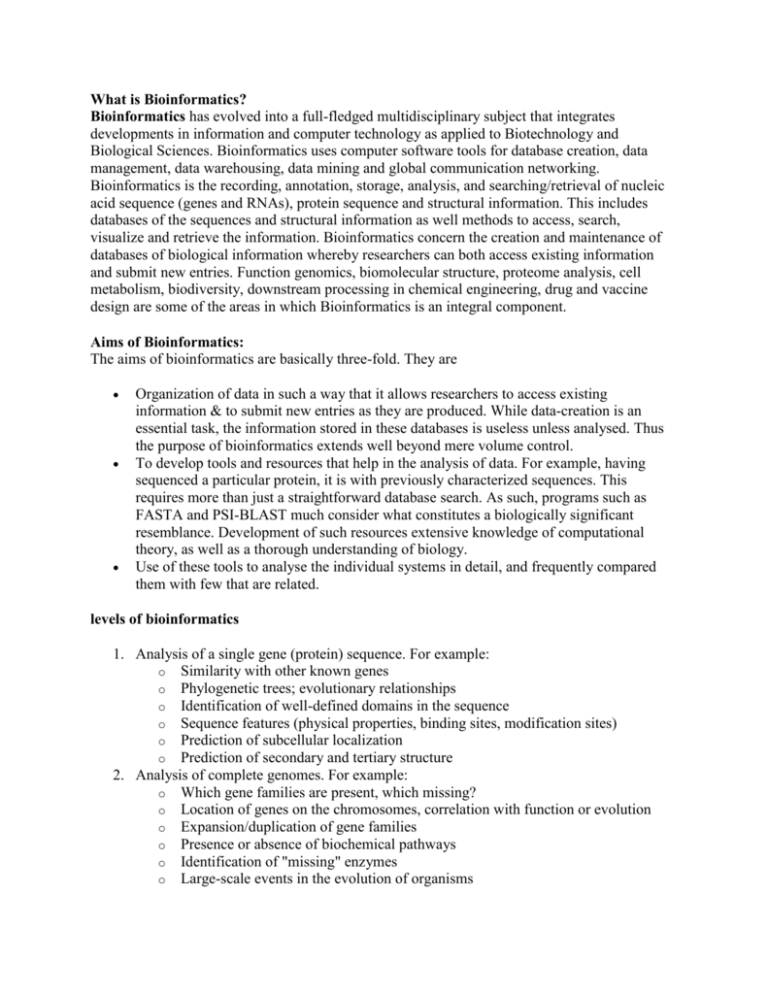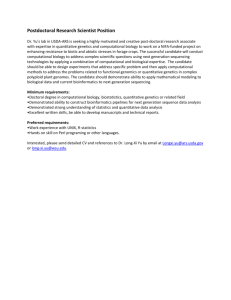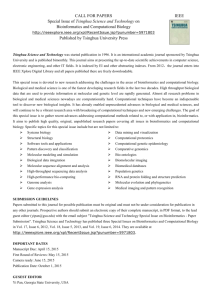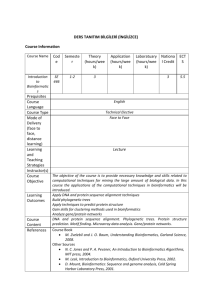What is Bioinformatics?
advertisement

What is Bioinformatics? Bioinformatics has evolved into a full-fledged multidisciplinary subject that integrates developments in information and computer technology as applied to Biotechnology and Biological Sciences. Bioinformatics uses computer software tools for database creation, data management, data warehousing, data mining and global communication networking. Bioinformatics is the recording, annotation, storage, analysis, and searching/retrieval of nucleic acid sequence (genes and RNAs), protein sequence and structural information. This includes databases of the sequences and structural information as well methods to access, search, visualize and retrieve the information. Bioinformatics concern the creation and maintenance of databases of biological information whereby researchers can both access existing information and submit new entries. Function genomics, biomolecular structure, proteome analysis, cell metabolism, biodiversity, downstream processing in chemical engineering, drug and vaccine design are some of the areas in which Bioinformatics is an integral component. Aims of Bioinformatics: The aims of bioinformatics are basically three-fold. They are Organization of data in such a way that it allows researchers to access existing information & to submit new entries as they are produced. While data-creation is an essential task, the information stored in these databases is useless unless analysed. Thus the purpose of bioinformatics extends well beyond mere volume control. To develop tools and resources that help in the analysis of data. For example, having sequenced a particular protein, it is with previously characterized sequences. This requires more than just a straightforward database search. As such, programs such as FASTA and PSI-BLAST much consider what constitutes a biologically significant resemblance. Development of such resources extensive knowledge of computational theory, as well as a thorough understanding of biology. Use of these tools to analyse the individual systems in detail, and frequently compared them with few that are related. levels of bioinformatics 1. Analysis of a single gene (protein) sequence. For example: o Similarity with other known genes o Phylogenetic trees; evolutionary relationships o Identification of well-defined domains in the sequence o Sequence features (physical properties, binding sites, modification sites) o Prediction of subcellular localization o Prediction of secondary and tertiary structure 2. Analysis of complete genomes. For example: o Which gene families are present, which missing? o Location of genes on the chromosomes, correlation with function or evolution o Expansion/duplication of gene families o Presence or absence of biochemical pathways o Identification of "missing" enzymes o Large-scale events in the evolution of organisms 3. Analysis of genes and genomes with respect to functional data. For example: o Expression analysis; microarray data; mRNA conc. measurements o Proteomics; protein conc. measurements, covalent modifications o Comparison and analysis of biochemical pathways o Deletion or mutant genotypes vs. phenotypes o Identification of essential genes, or genes involved in specific processes Bioinformatics and computational biology Bioinformatics and computational biology each maintain close interactions with life sciences to realize their full potential. Bioinformatics applies principles of information sciences and technologies to make the vast, diverse, and complex life sciences data more understandable and useful. Computational biology uses mathematical and computational approaches to address theoretical and experimental questions in biology. Although bioinformatics and computational biology are distinct, there is also significant overlap and activity at their interface. Biocomputing Biocomputing is often used as a catch-all term covering all this area at the intersection of Biology and Computation , although many other terms are used to name the same area. We can distinguish in to (non-disjoint) sub-fields: Bioinformatics - this includes management of biological databases, data mining and data modeling, as well as IT-tools for data visualization Computational Biology - this includes efforts to solve biological problems with computational tools (such as modeling, algorithms, heuristics) DNA computing and nano-engineering - this includes models and experiments to use DNA (and other) molecules to perform computations Computations in living organisms - this is concerned with constructing computational components in living cells, as well as with studying computational processes taking place daily in living organisms Computational Biology Computational Biology is application of core technology of computer science (eg. algorithms, artificial intelligence, databases etc) to problems arising from biology. Computational biology is particularly exciting today because the problems are large enough to motivate the efficient algorithms and moreover the demand of biology on computational science is increasing. The most pressing tasks in bioinformatics involve the analysis of sequence information. Computational Biology is the name given to this process, and it involves the following: Finding the genes in the DNA sequences of various organisms Developing methods to predict the structure and/or function of newly discovered proteins and structural RNA sequences. Clustering protein sequences into families of related sequences and the development of protein models. Aligning similar proteins and generating phylogenetic trees to examine evolutionary







